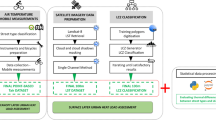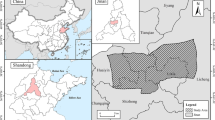Abstract
To estimate the impact of street characteristics on the thermal environment in an urban street canyon in a hot and humid region, transect data were used to analyze the relation between three factors (urban green ratio, building ratio, and height-to-width ratio) and air temperature in two streets in Taichung City, Taiwan. In this study, air temperature data were collected by transects at four different level heights (1, 2, 3, and 4 m height) in two streets; meanwhile, the use of three street characteristics data calculated by geographic information system (GIS) data which can represent the environment conditions of 34 measured locations. The analysis results shows that the air temperature significantly correlated with height-to-width ratio (r = 0.481), green ratio (r = 0.729), and building ratio (r = 0.654), respectively, at night. In conclusion, this study demonstrates that increasing the green ratio and decreasing the building density are important strategies to mitigate urban warming and to create a comfortable thermal environment.












Similar content being viewed by others
References
Alexandri E, Jones P (2008) Temperature decreases in an urban canyon due to green walls and green roofs in diverse climates. Build Environ 43:480–493
Ali-Toudert F, Mayer H (2007a) Effects of asymmetry, galleries, overhanging façades and vegetation on thermal comfort in urban street canyons. Sol Energy 81:742–754
Ali-Toudert F, Mayer H (2007b) Thermal comfort in an east–west oriented street canyon in Freiburg (Germany) under hot summer conditions. Theor Appl Climatol 87:223–237
Chow WTL, Pope RL, Martin CA, Brazel AJ (2011) Observing and modeling the nocturnal park cool island of an arid city: horizontal and vertical impacts. Theor Appl Climatol 103:197–211
Eliasson I (1996) Urban nocturnal temperature, street geometry and land use. Atmos Environ 30(3):379–392
Emmanuel R (2009) Sustainable urbanity and urban climate change: amelioration of UHI’s as a quality-of-life agenda for tropical mega-cities. Proceeding of The seventh International Conference on Urban Climate, Yokohama, Japan
Georgakis C, Santamouris M (2006) Experimental investigation of air flow and temperature distribution in deep urban canyons for natural ventilation purposes. Energy Build 38:367–376
Hwang RL, Lin TP, Cheng MJ, Lo JH (2010) Adaptive comfort model for tree-shaded outdoors in Taiwan. Build Environ 45(8):1873–1879
Hwang RL, Lin TP, Matzarakis A (2011) Seasonal effects of urban street shading on long-term outdoor thermal comfort. Build Environ 46(4):863–870
Johansson E (2006) Influence of urban geometry on outdoor thermal comfort in a hot dry climate: a study in Fez, Morocco. Build Environ 41:1326–1338
Kruger E, Pearlmutter D, Rasia F (2010) Evaluating the impact of canyon geometry and orientation on cooling loads in a high-mass building in a hot dry environment. Appl Energy 87:2068–2078
Lin TP, Matzarakis A, Hwang RL (2010) Shading effect on long-term outdoor thermal comfort. Build Environ 45(1):213–221
Niachou K, Livada I, Santamouris M (2008) Experimental study of temperature and airflow distribution inside an urban street canyon during hot summer weather conditions—part I: air and surface temperatures. Build Environ 43:1383–1392
Oke TR (1987) Boundary layer climates, 2nd edn. Methuen, London
Oke TR, Johnson GT, Steyn DG, Watson ID (1991) Simulation of surface urban heat islands under ideal conditions at night. Part 2. Diagnosis of causation. Bound-Lay Meteorol 56:258–339
Pearlmutter D, Bitan A, Berliner P (1999) Microclimatic analysis of “compact” urban canyons in an arid zone. Atmos Environ 33:4143–4150
Priyadarsini R, Hien WH, David CKW (2008) Microclimatic modeling of the urban thermal environment of Singapore to mitigate urban heat island. Sol Energy 82:727–745
Rosenfeld AH, Akbari H, Bretz S, Fishman BL, Kurn DM, Sailor D, Taha H (1995) Mitigation of urban heat islands: materials, utility programs, updates. Energ Build 22:255–265
Santamouris M, Papanikolaou N, Koronakis I, Livada I, Asimakopoulos D (1999) Thermal and air flow characteristics in a deep pedestrian canyon under hot weather conditions. Atmos Environ 33:4503–4521
Shashua-Bar L, Hoffman ME (2000) Vegetation as a climatic component in the design of an urban street. Energy Build 31:221–235
Shashua-Bar L, Hoffman ME (2003) Geometry and orientation aspects in passive cooling of canyon streets with trees. Energy Build 35:61–68
Shashua-Bar L, Tsiros IX, Hoffman ME (2010) A modeling study for evaluating passive cooling scenarios in urban streets with trees. Case study: Athens, Greece. Build Environ 45:2798–2807
Sun CY, Brazel AJ, Chow WTL, Hedquist BC, Prashad L (2009) Desert heat island study in winter by mobile transect and remote sensing techniques. Theor Appl Climatol 98:323–335
Wilmers F (1991) Effect of vegetation on urban climate and buildings. Energy Build 15–16:507–514
Acknowledgments
The support of National Science Council (project NSC 98-2218-E-004 -001), Republic of China (Taiwan), is gratefully acknowledged. The text was proofread by Jennifer Butler.
Author information
Authors and Affiliations
Corresponding author
Rights and permissions
About this article
Cite this article
Sun, CY. A street thermal environment study in summer by the mobile transect technique. Theor Appl Climatol 106, 433–442 (2011). https://doi.org/10.1007/s00704-011-0444-6
Received:
Accepted:
Published:
Issue Date:
DOI: https://doi.org/10.1007/s00704-011-0444-6




